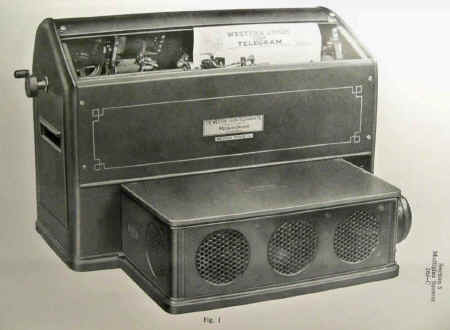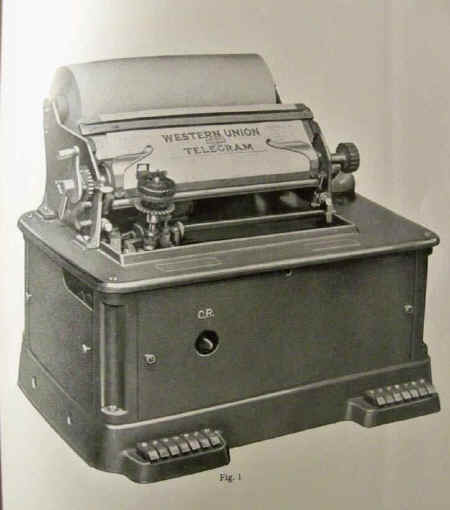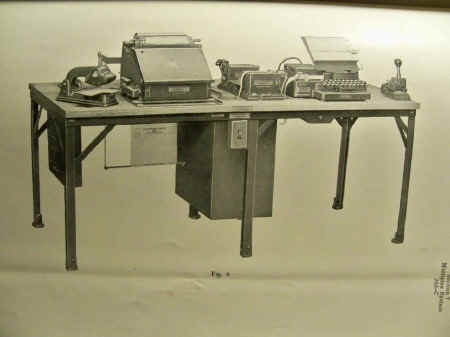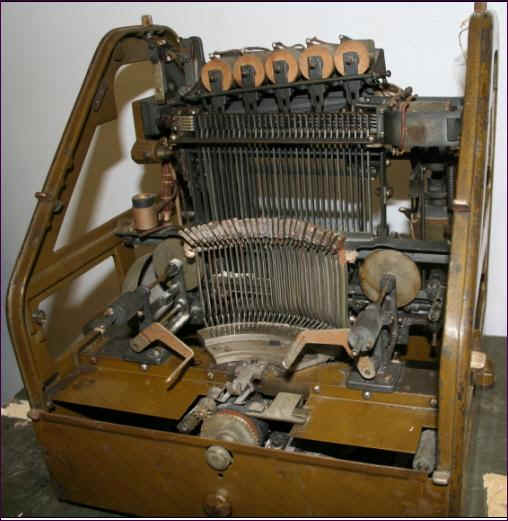|
| |
| |
| |
| Duncan brown Teletype Curator at the AWA museum tells
us -
There are not too many of the M21-A vintage units left, so it will be
hard to find any parts. They were designed around 1920 for Western
Union Multiplexed systems (four circuits on one pair of wires) and were
used up until the 1940-50s. (I'm surprised that Bul. 139 is dated Dec,
1947, but apparently there were still systems using the equipment then
and Teletype Corp. was still supporting them.)
The selector magnets were each pulsed and then mechanically latched into
place until the unit received the print command. If you put in a piece
of tape and a ribbon in the unit, you can press down on individual
selector magnets to latch in a letter code, then press down on the print
solenoid and print the letter on the tape.
To operate the older units with five selector magnets, you needed a
serial to parallel converter or "Receiving Distributor."
There is an
article in the April 1962 issue of RTTY magazine that has an electronic
distributor for the WU M21-A. There is also a M21-A parts
manual (Bul. 1027; March 1947)
Alas some comments by those who tried this...
On 2/2/2015 9:06 AM, Duncan Brown wrote:
There is an article in the April 1962 issue of RTTY magazine
that has
an electronic distributor for the WU M21-A.
Oh this is absolutely precious. 24 tubes. It would be even
more if it
wasn't for the 6SL7 dual triodes and 6H6 dual diodes.
Jim Haynes comments: And if you should be so foolish as to
attempt to build the circuit...
There was an error in the schematic - I don't recall offhand if the
1962 reprint has it corrected. Also as I recall W6ZBV later
replaced
the 6V6 and millisec relay with a 2050 thyratron..
I actually built the circuit, but never got it to work. Didn't
know about
the schematic error. Was using junk-box pots. Had no means
of testing
and adjusting. Well if I had been smarter I could have built a
multivibrator that would be adjustable to the various pulse lengths,
but then I didn't have a calibrated triggered sweep scope to set it
with.
|
|
Duncan Brown explains "Here is another picture of a WU multiplexed
operating table. (Mux
Operating Table - WU). The perforator is a "Multiplex
Perforator 2A" by
Morkrum (aka "Iron Horse"). There is a "Multiplex
Transmitter 1-A" and a
"Multiplex Printer 1-A", both by Kleinschmidt Electric Co.
The box
behind the tape transmitter is a "Multiplex Automatic Control
1-A", also
by KEC; it is finger-powered and generates a FIGS-J-LTRS code
combination to ring the bell at the other end without disturbing the tape.
This came from a c1925 WU book on Multiplex Printing Telegraph Systems
with a lot of good photographs & drawings.
There are photos of a couple of printers I had never seen before - a WE
Mux Printer - WU 1A and an unidentified manufacturer Mux printer WU 5-A."


|

The picture enclosed shows a Western Union Operating table of about
1920. The perforator is on the right, with the tape reader to its left
(look closely and you can see the loop of tape between the two). The
tape reader read the 5 bits in parallel, then they were sent to a
parallel to serial converter (distributor) where they were (time
division) multiplexed with up to 3 other circuits and sent out
(serially) on the line. A page printer is on the left.
added note - -
Western Union bought equipment from a lot of different manufacturers
and
put their own name & model number on them. But they often used
the same
model number for different types of equipment. for Example, you have
a
WU Model 22-A tape reader, but there was also a WU Model 22A tape
printer, so it can be confusing.
(Courtesy Duncan Brown AWA Museum)
|
|

Duncan says:
Enclosed is a picture of our Kleinschmidt Electric 20A. The
tape is
stored in a drawer on the bottom. As part of the same donation that
the
M12s came from, there is at least one unit marked "21-A" I took
a quick
look at it (still in its packing box). It looks similar to the KEC 20A,
but there were no side frames and the tape reel was mounted on the
side. I'll have to take a closer look at these and see about latches
on
the selector magnets.
Were the "20-A" and "21-A" WU numbers??
Jim Haynes wrote:
I've never seen a Model 20 close up, but the 21A printer does have
a latching mechanism, so that the electromagnets are operated one at
a time as the receiving distributor sweeps over its brushes. The
magnets themselves don't latch, but they release mechanical latches
that activate the code bars when the machine is about to print.
|
|